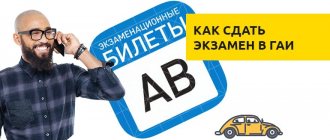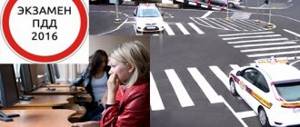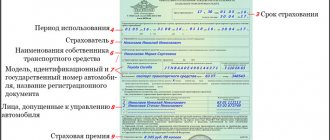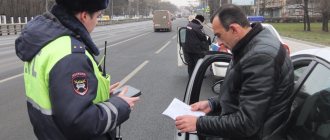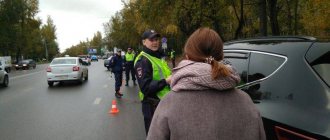So why do most newbies fail this city driving test the first time?
It's all about their level of training, inexperience and, of course, their nerves themselves. Unlike experienced drivers, driver candidates usually tend to be very nervous during their first traffic police exam. But then how can you make yourself less nervous during the exam? Indeed, in such a “situation”, in any case, each of the beginners will definitely be nervous when taking the exam. In fact, our nerves during our first traffic police exam are directly related to our lack of self-confidence. And it primarily arises due to insufficient training of a novice driver.
Trust us, friends, if you are well prepared and learn to drive a car quite well in difficult urban conditions, then you will (and will become) more confident when taking the exams. So remember, if you are very nervous, then you may not be ready to get your first license yet. Maybe it would be better for you to continue practical driving lessons in the city with a driving instructor? Consider this advice.
Or perhaps you need (need) to change your instructor teacher.(?)
After all, it’s not uncommon for a driving instructor to simply not suit you. It also happens that citizens (newbies and future drivers) complain about their driving teachers, that they deliberately do not want their students to pass all the traffic police exams right away, the first time, in the hope that in the future they will apply again to them for help in order to somehow come to an agreement with the State Traffic Inspectorate employees themselves, with whom they usually already have acquaintances.
Another reason for our mistakes and failures at our first driving test in the city is ordinary human stress, which, as has already been established, is associated with great stress when driving a car around the city.
Don’t forget, friends, that what will be sitting next to you during the exam is not your driving instructor, to whom you are already accustomed, but a strict traffic police officer, who will give you penalty points for your slightest mistakes (which are often ignored by driving instructors). .
Ultimately, in such a situation, we begin to get very nervous and all our acquired knowledge in a driving school instantly disappears, thereby reducing the chances of every novice driver to successfully pass the practical exam to virtually zero.
Believe me, dear friends, even well-prepared beginners (future drivers) often make simply stupid mistakes in their first exams. It is from here that rumors arise (appear) that traffic police officers deliberately “fail” all new drivers (although it must be admitted that sometimes it actually happens that examiners actually “fail” candidates) so that they come back to take the driving test. But most often, the reason for such failures is the drivers themselves, who are very nervous during the exam and constantly forget about the knowledge they acquired while studying at a driving school.
Dear readers, future novice drivers, please do not hope that all our advice will help you pass the traffic police test for driving in the city 100% and right the first time. In fact, this task is assigned to your (or any) driving instructor. Only he can directly prepare you in such a way that you have a reasonable chance of passing such an exam the very first time.
The purpose of our advice is primarily the following, namely, to increase your chances of successfully passing practical driving tests at the traffic police.
We hope our recommendations will help you prepare well for such exams in the city. From such advice you will learn what you should expect at the traffic police exams, what you need to do or undertake so as not to be nervous during them (the exams), and so on, etc. All our advice will definitely (we hope) help you get a driver’s license the first time.
What to expect from your practical city driving test.
The practical driving test is the final hurdle in the process of obtaining your first Russian driver's license. In order to obtain admission to the exams in the city, you will need to initially pass (pass) a theoretical exam (testing knowledge of traffic rules) as well as a practical exam at the traffic police site, where you will need to perform a number of mandatory exercises (snake, overpass, entry into garage, turning around in a confined space, etc.). After successfully passing the theory and the stage at the traffic police, you receive access to exams in the city.
This practical exam takes a minimum of 20 minutes. During this time, the traffic police inspector checks how prepared you are to participate in traffic on public roads. On September 1, 2021, new administrative regulations of the State Traffic Safety Inspectorate came into force, which somewhat complicated the entire procedure for taking driving license exams in the State Traffic Safety Inspectorate.
For example, when passing the theory (theoretical exam), new questions appeared on the tickets, and if the question is answered incorrectly, the driver candidate will now have to answer 5 additional questions.
As for practical exams, new exercises have appeared on the site - now, instead of three mandatory exercises, a driver candidate must complete at least five exercises, and when passing the city (driving) exam, many minor mistakes will now (according to the new rules) be recognized as average errors. So, for example, instead of 1 (one) penalty point, the traffic police officer will now be required to award the candidate driver at least 3 (three) points for not wearing a seat belt.
Here, dear readers, is a mandatory list of skills that a traffic police officer must check during a practical driving test in the city:
What does a traffic police officer check during a practical test (driving) in the city when passing for a category “B” license?
— Driving through a controlled intersection (if there is one in the service area of the examination unit) (subclause 10.1 of the traffic rules).
— Driving through an unregulated intersection of equivalent roads (if there is one in the service area of the examination unit) (subclause 10.2 of the traffic rules)
— Driving through an unregulated intersection of unequal roads (subclause 10.3 of the traffic rules).
— Left, right turns and U-turns at intersections (subclause 10.4 of traffic rules).
— Turn around outside the intersection (subclause 10.5 of traffic rules).
— Passing a railway crossing (if there is one in the service area of the examination unit) (subclause 10.6 of the traffic rules).
— Changing lanes on a section of road that has 2 or more lanes for traffic in one direction (if they exist in the service area of the examination unit) (subclause 10.7 of the traffic rules).
— Overtaking or advancing (subclause 10.8 of traffic rules).
— Driving at the maximum permitted speed (subclause 10.8 of the traffic rules).
— Passage of pedestrian crossings and stops of route vehicles (subclause 10.10 of the traffic rules).
— Braking and stopping when driving at various speeds (subclause 10.11 of the traffic rules).
As we have already said, for each mistake in the city driving test, the examiner will award (you) penalty points in accordance with the violation of each traffic rule, as well as other practical errors (for example, when the car engine stalled at the start, the traffic police officer will award one penalty point per candidate).
How to pass driving in the city
The last and most difficult part of the test is city driving. It is at this stage that many driver candidates continue to remain so until the next retake. The duration of the exam is about 15-20 minutes. Penalty points are awarded for errors: five for gross, three for average and one for minor violations. If a driver candidate scores more than four penalty points, the exam is considered failed.
A student may be immediately sent to retake for the following violations:
- Crossed a solid marking line, a stop line;
- Driving through a prohibiting traffic light or traffic controller;
- Drifted into oncoming traffic;
- Did not give way to a vehicle having priority;
- Did not give way to pedestrians at a zebra crossing;
- Did not comply with the requirements of road signs;
- Violated the speed limit;
- Violated the rules for overtaking, turning, turning around, or passing railway tracks;
- Through his rash actions, he allowed the instructor to interfere in the management of the vehicle.
The student will receive three points if:
- Didn't fasten his seat belt.
- I was talking on the phone while driving.
- Violated the rules for transporting passengers.
- Didn't slow down when the situation required it.
- Stopped or parked in the wrong place.
- Did not turn on the turn signal when the situation required it.
- I drove into an intersection (during a traffic jam), creating an obstacle for cars moving in the transverse direction.
- Failed to turn on the hazard lights or display a warning triangle when the situation required.
- Did not comply with road marking requirements.
And finally, a student faces one point if he:
- Interfered with other vehicles by driving at too low a speed.
- While driving, the engine stopped unexpectedly (i.e. stalled).
- Didn't look in the rearview mirrors.
- Performed sudden braking when it was not necessary.
- Poor orientation in the road situation.
- Did not turn on the running lights (low beam).
- Violated the rules for using the sound signal.
- He drove the car uncertainly.
- Incorrectly selected the driving speed in accordance with the weather conditions.
- Turned on the turn signal too early or too late.
- Violated the rules for placing a car on the road.
Good knowledge of the test route will give you an advantage when taking the city driving test. Familiarize yourself with future routes in advance, carefully study all road signs and difficult sections of the road, such as intersections with multiple lanes. You also need to pay special attention to the places on your future examination route where it is allowed to make a U-turn and where not.
Take a good look at your driving skills. Not all people have enough standard hours in a driving school to learn to drive a car confidently. If you have any skill gaps, don't rely on luck - they will definitely come out in the exam. After all, the route is designed in such a way as to test all the basic skills of the candidate driver. Take extra hours of driving and practice the elements that are difficult for you. When driving a car with a manual transmission, the skill of shifting gears must be brought to automaticity, otherwise you will be constantly distracted on the road.
Do not forget that whenever you stop, the manual transmission must be switched to neutral and the car must be put on the handbrake. Always start in first gear, do not try to change into a higher gear immediately, otherwise the engine will stall.
As when passing the race track, first of all, adjust the driver’s seat, then the rear-view mirrors, and then fasten your seat belt, check whether the running lights (low beam) are on. Before driving, make sure that the car's handbrake is released.
If it's raining, turn on the air conditioning and heated rear window - this will help prevent the car windows from fogging up. Before you start moving and then during each maneuver, do not forget to turn on the turn indicators; it is enough to fail to do this twice and you can go for a retake.
Often, a traffic police officer, in order to test knowledge of traffic rules, gives the candidate driver tasks with a trick. For example, it may ask you to find a place to turn around, which may not be on the nearest section of the road, but after 2 intersections, for example. Or they say, at a controlled intersection, turn left, and the cadet must drive straight through all intersections without traffic lights until he reaches a controlled intersection, where he makes a turn.
Therefore, listen carefully to the inspector’s commands and if they contradict the traffic rules, then point this out to him. And if something is not clear, then it’s better to ask again; you won’t be punished for this and you won’t get penalty points. Well, learn the traffic rules well so that you are fully prepared.
Be sure to check the road conditions in your rearview mirrors. If you go around a car standing on the road, keep a safe distance (lateral distance), about one meter. In this case, if a car door suddenly opens, you can avoid a collision. When driving around, remember to turn on your turn signals.
In general, try to always keep a greater distance from the car in front. On wet or icy roads, your car's braking distance increases significantly. And by approaching a neighboring car, the driver has a chance to crash into it. Therefore, you should make it a rule to maintain a safe distance in any conditions.
Typical mistakes of driver candidates in urban environments:
- Started moving without the inspector's command.
- Didn't fasten his seat belt.
- Exceeded the speed limit, or, conversely, drove too slowly.
- Forgot to turn on the turn signal.
- Did not give way to a pedestrian at a zebra crossing.
- Did not give way to a vehicle having priority.
- Parked in the wrong place.
- When approaching the intersection, he began to change lanes across a solid marking line.
- Stopped behind the stop line.
Avoid these mistakes and then you will pass the exam successfully. Well, when all the stages are over, you can go and get your license. But before this joyful event, it is necessary to pay a state fee in the amount of two thousand rubles (three thousand for a new generation certificate). If you don’t have the opportunity to pick up your license in the near future, don’t worry - you can do this on any convenient day, month or even year.
For which traffic violations during a city driving test does the examiner immediately give an o?
According to the new regulations (rules) of the State Traffic Safety Inspectorate regulating the procedure for taking license exams during a practical driving test in the city, for gross violations of traffic rules, the candidate driver is awarded 5 penalty points and he is immediately suspended from further exams, and is marked on the examination sheet O.
Here is a list of those gross traffic violations for which 5 penalty points are awarded:
— Driving into the oncoming lane of the road.
— Failure to give way in accordance with traffic rules to other vehicles or pedestrians, as well as for ignoring special regulations signs.
— Driving through a section of road at a red traffic light.
— Exceeding the established or permitted speed.
— Driving beyond the stop line at a traffic light or at a stop sign.
— Failure to follow the instructions of the examiner (traffic police officer).
— Overtaking a vehicle with special signals turned on.
— Overtaking a car that has stopped in front of a pedestrian crossing.
— In case of repeated violation of traffic rules.
As a result, a driver candidate, upon receiving 5 penalty points for the above gross traffic violations and having also collected the same 5 penalty points for other minor violations, is sent to retake the exam, which, according to the law, cannot be held earlier than 7 days later since the last exam taken. True, in the same practice, on average you have to wait about 1 month before the next exam, since in many departments (divisions) of the State Traffic Inspectorate there is a queue of the same driver candidates. This is primarily due to the fact that the traffic police cannot check the driving skills of such a huge number of drivers every day, who constantly contact them to pass a practical exam. It is for this reason that such queues form for exams at the traffic police.
Attention! The results of theoretical and practical exams on the site are valid for no more than 6 months from the date of successful completion. That is, to pass the practical traffic police exam on driving in the city, you have 6 months left from the moment you pass the theory and on-site exam. Otherwise you will have to retake everything again.
Where is the traffic police practical driving test in the city held?
According to the administrative regulations of the Ministry of Internal Affairs of the State Traffic Safety Inspectorate of the Russian Federation, the practical examination of a driver candidate is carried out along pre-approved routes, which are established by the examination department of the State Traffic Inspectorate. According to the law, such routes must be approved by the Head of the examination department of the traffic police and posted on stands for their familiarization.
It is worth immediately noting that the traffic police authorities periodically change such (their) routes for driving tests in the city, in order to improve the quality of examinations and to fairly test the driving skills of driver candidates, as well as to test knowledge of traffic rules specifically and directly in practice. It just sometimes turns out that many driving instructors, knowing in advance about such routes where traffic police officers conduct driving tests in the city, begin to drive their novice drivers along these routes ahead of time in the hope that they will remember by heart all these necessary nuances of the routes and easily will be able to pass a practical driving test in the city, which will be a good advertisement for them among subsequent students.
You can find out about current exam routes in the city directly from your department or traffic police department, using the official website of the State Traffic Inspectorate.
To do this, go to: https://www.gibdd.ru/gosuslugi/reg/exm/
Next, select from the list the traffic police department that interests you, which conducts exams for obtaining a driver’s license. Then you will be provided with information about the work schedule of this department, the bank details of the department and several official routes along which practical driving tests are taken in the city.
How many times can you take the city driving test?
The maximum number of possible retakes is not limited. But you can retake driving only within six months after the first attempt. If you do not meet the six-month deadline, you will have to retake all exams, including theory and racing.
You can retake all exams an unlimited number of times. If, after an unsuccessful attempt, you moved to another city, you can take the exam again there. It is important that you have a certificate of completion from a driving school. If it is not there, then time and money on training are wasted. And in order to try to pass the driving exam again, you will have to re-learn.
This state of affairs is relevant for 2021. If you have taken too long with the retake, it is better to make sure that the rules have not yet changed.
“The inspectors really suck, but you shouldn’t be offended by them. The inspector taking the exam sees the driver candidate for only 15 minutes. During this time, he must determine whether the student can drive or not. Acceptors create the most difficult conditions to determine the candidate’s readiness to obtain a driver’s license.
Statements that you cannot pass the exam in the city are myths. It's realistic to give it up. The cars are equipped with five cameras, each of which monitors what is happening on the road and inside the car. Do not forget that in the learning process it is not enough to gain an understanding of what is happening on the road. It is also necessary to gain experience in driving and behavior in emergency situations.”
